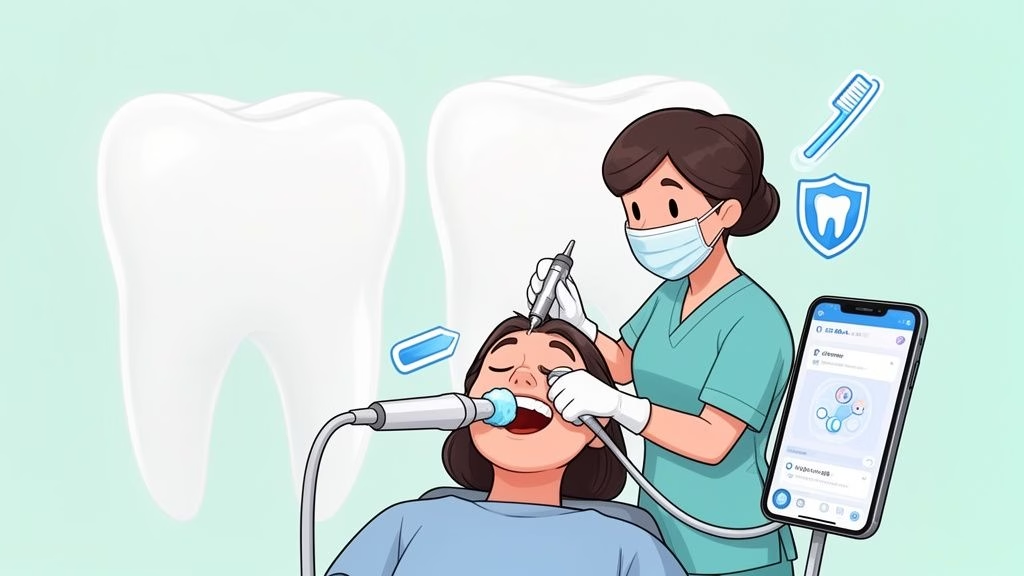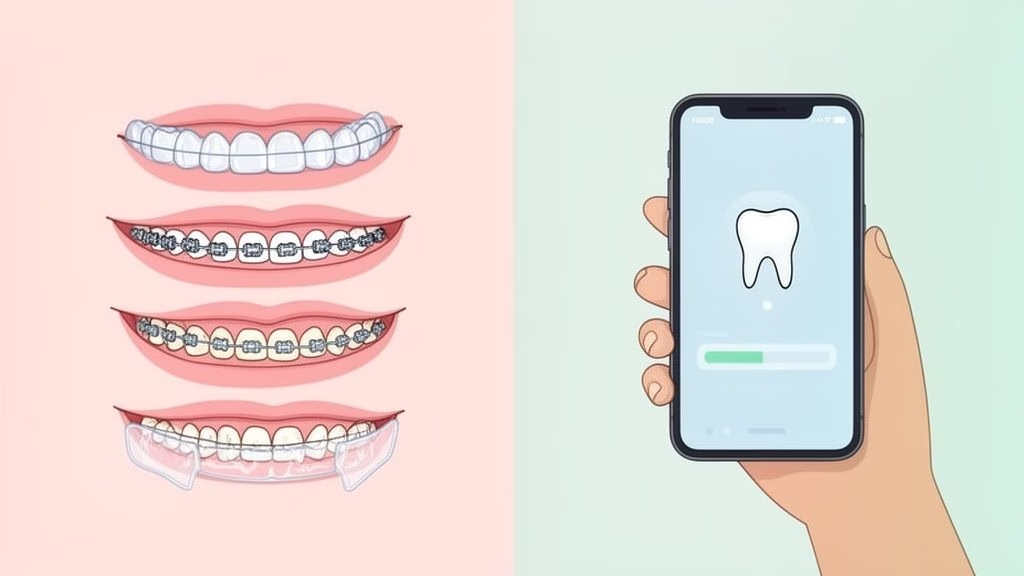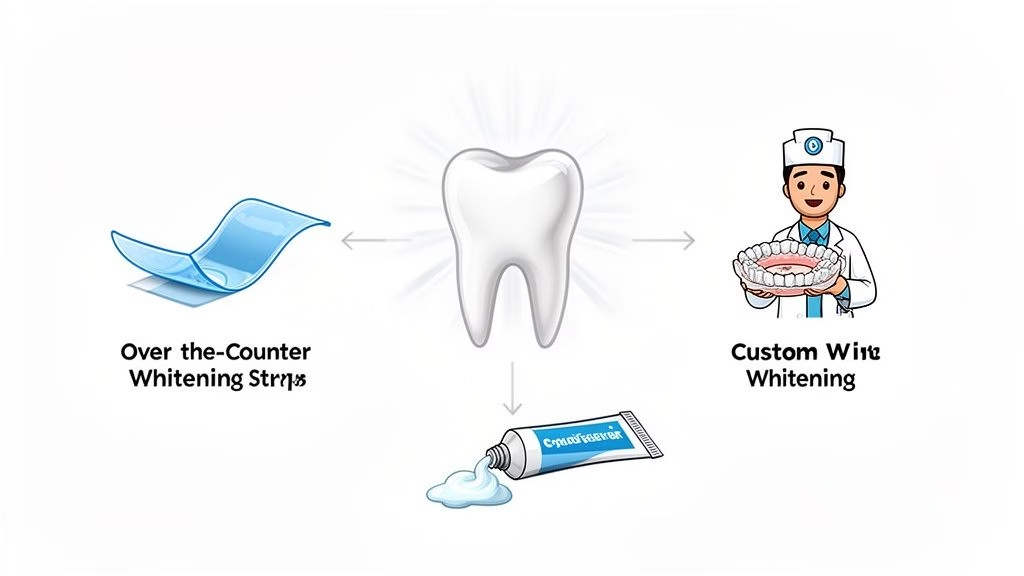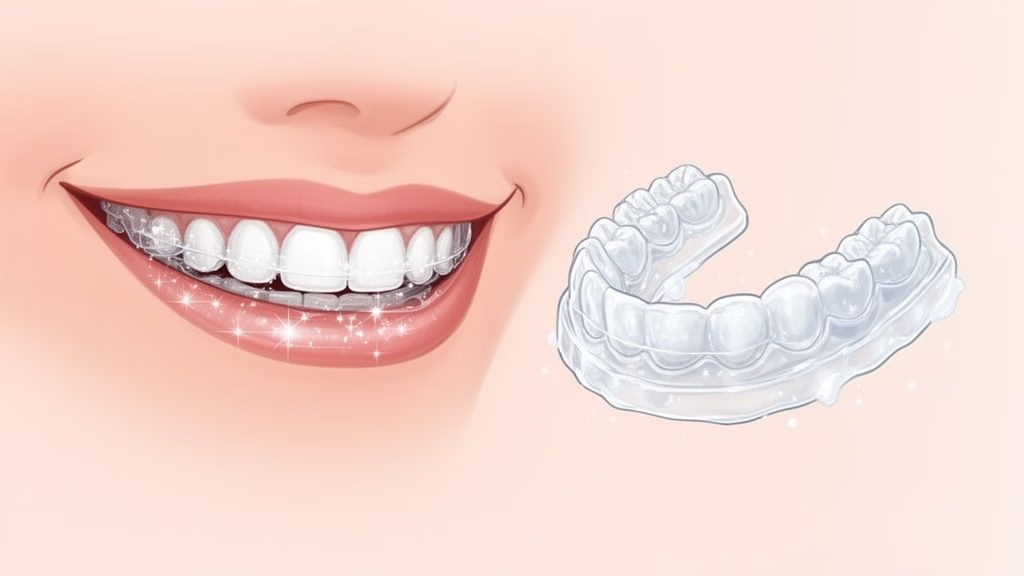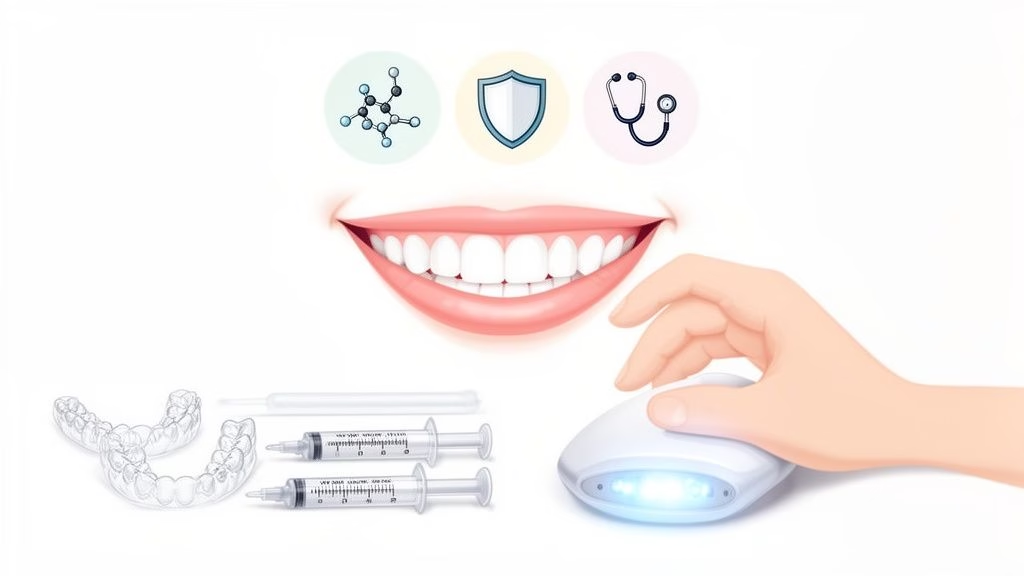Can a Retainer to Straighten Teeth Actually Work?
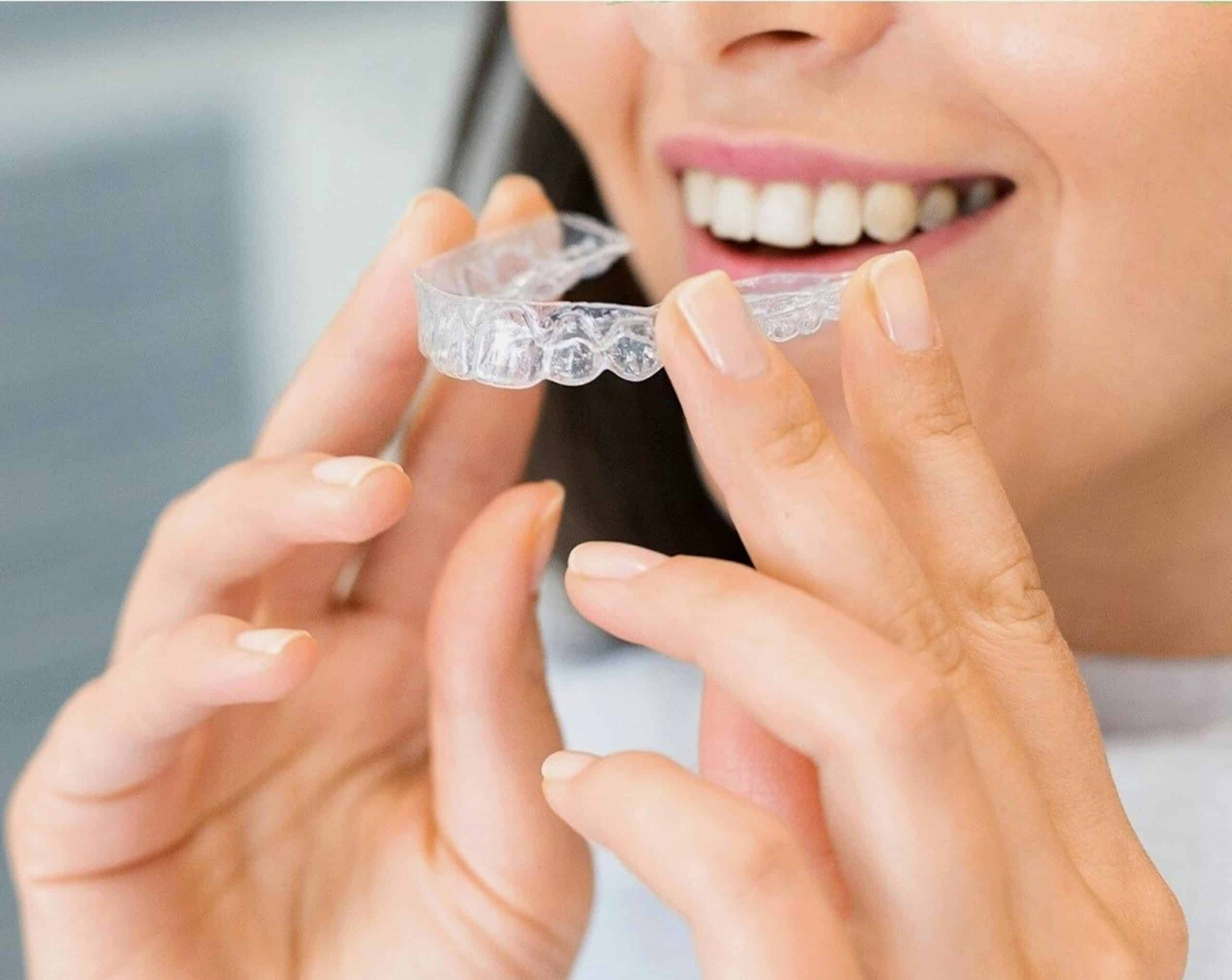
You might have heard whispers that a simple retainer can straighten your teeth, and it’s an appealing thought. Can you really skip a full orthodontic treatment? The short answer is yes, but with a huge caveat: a retainer can only fix extremely minor issues, like a single tooth that’s nudged itself slightly out of line.
For anything more than that, you’re asking the wrong tool to do the job. Think of a retainer’s role as a security guard for your smile – its primary mission is to hold everything in place, not to undertake a major reorganisation. For a smarter, more affordable way to actively move your teeth, you need a solution designed for the job, like the clear aligners offered by Toothfairy.
The Real Role of an Orthodontic Retainer
It’s a common question, but it stems from a slight mix-up about what retainers are actually built for. Imagine you’ve just had your garden perfectly landscaped. A retainer is like the subtle edging you put around the flowerbeds; it keeps everything looking sharp and prevents the soil from spilling over. It doesn’t, however, have the power to dig up and move the entire lawn.
In much the same way, retainers are custom-made devices designed to maintain the beautiful results you get from braces or clear aligners. After your teeth have been gently guided into their ideal spots, the bone and tissues surrounding them need time to catch up and solidify. Without a retainer, your teeth have a natural memory and will try to drift back to their old positions. This unwelcome shift is known as orthodontic relapse.
This is why a retainer is all about preservation.

As you can see, its core purpose is to lock in your new smile and make sure all that hard work wasn’t for nothing.
Why Maintenance is Non-Negotiable
The need for retainers isn’t just a suggestion; it’s a cornerstone of modern dental care. In the UK alone, around 200,000 young people get orthodontic treatment on the NHS each year, and almost every single one of them will need a retainer to protect that investment. Its job is to hold the teeth steady while the jawbone firms up around their new home. You can read more about the widespread use of retainers in UK orthodontics to understand just how crucial they are.
A retainer’s job is fundamentally passive. It provides a fixed boundary, preventing your teeth from drifting. It doesn’t apply the active, sequential force needed to guide teeth through significant movements.
Trying to force a standard retainer onto teeth that have already moved can do more harm than good. At best, it won’t work. At worst, you could damage your tooth roots or gums. While some specialised “active retainers” exist for tiny tweaks, they are absolutely no substitute for a proper straightening system.
If you want to actively change your smile, you need a tool designed for movement. This is where modern clear aligners have completely changed the game.
Retainer vs. Aligner A Quick Comparison
It’s easy to confuse the two since they can look similar, but their jobs are worlds apart. This table breaks down the key differences between a traditional retainer and an active clear aligner system like Toothfairy.
| Feature | Traditional Retainer | Active Clear Aligner (like Toothfairy) |
|---|---|---|
| Primary Purpose | To hold teeth in their final position post-treatment. | To actively move teeth into a new, straighter position. |
| Force Applied | Passive. It provides a static boundary to prevent relapse. | Active. Applies gentle, controlled pressure to create movement. |
| Treatment Process | A single appliance worn long-term to maintain results. | A series of custom trays, each worn for 1-2 weeks. |
| Best For | Preventing teeth from shifting back after braces or aligners. | Correcting mild to moderate crowding, spacing, and bite issues. |
Ultimately, a retainer is for maintenance, while an aligner is for movement.
Solutions like Toothfairy offer a dentist-supervised, app-based way to achieve genuine straightening. They provide a smarter, more affordable path to the smile you want, without the limitations of trying to make a retainer do a job it was never designed for.
Can Retainers Actually Straighten Teeth?
You might have heard whispers that retainers can do more than just hold your teeth in place. While their main job is definitely to maintain the beautiful smile you’ve already achieved, there’s a small grain of truth to the idea they can make minor tweaks. But this is a very specific, niche situation.
Think of it this way: after years of wearing braces, one of your front teeth has decided to wander just a tiny bit, maybe a single millimetre. In a case like this, a dentist might prescribe a special active retainer. This isn’t your standard, passive retainer. It’s built with small springs or clasps designed to apply a gentle, targeted nudge to guide that one rebellious tooth back into line.
It’s a delicate, precise fix for a tiny problem—like using tweezers to adjust a single delicate component in a watch. If you have several crooked teeth or a noticeable gap, trying to fix it with a retainer would be like trying to build the entire watch with just those tweezers. It’s simply not the right tool for the job.

When an Active Retainer Might Be an Option
Let’s be clear: using a retainer for tooth movement is the exception, not the rule. It’s a method reserved for very specific scenarios and always requires professional supervision from a dentist or orthodontist.
So, when might it actually be on the table?
- Extremely Minor Relapse: This is the classic case. It’s for people whose teeth have shifted ever so slightly years after they finished their orthodontic treatment. We’re talking about movement of less than 1-2 millimetres.
- A Single Tipped Tooth: An active retainer might be able to correct one tooth that has tipped a little bit forwards or backwards. It’s important to know it can’t rotate a tooth or move it up or down.
- Closing a Hairline Gap: Very rarely, a specially designed retainer could be used to close a tiny gap that has reappeared between two teeth.
Even when the conditions are perfect, the results aren’t as predictable as a system that’s actually built for moving teeth.
An active retainer is a specialised tool for micro-adjustments, not a shortcut to a straighter smile. Trying to force a standard retainer to move teeth can apply dangerous pressure and risk damaging your teeth and gums.
Why Aligners are the Right Tool for the Job
When the goal is to actively straighten your teeth, clear aligners are what you need. They are engineered from the ground up for this very purpose. While an active retainer is a single tool for a single, tiny task, a full aligner system is the complete toolkit, designed to manage a whole range of alignment issues with incredible precision.
Gone are the days when getting aligners meant endless trips to the clinic. Modern solutions like Toothfairy have made the whole process far more straightforward, blending professional dentist supervision with a user-friendly app. You get a series of custom-made aligners sent to you, with each one picking up exactly where the last one left off. It’s a seamless, predictable journey to the smile you want. Toothfairy is a smarter and more affordable way to get the smile you’ve dreamed of.
So, while a retainer can sometimes nudge a stray tooth back home, its power is very limited. For anyone looking for a real change, clear aligners are the smarter, safer, and much more effective way forward. They’re designed for the entire journey of straightening teeth, not just for guarding the final destination.
Getting to Grips with Different Types of Retainers
Retainers aren’t a one-size-fits-all solution. The specific type you have plays a huge role in whether it can be used for tiny adjustments or just for holding your teeth steady. Each design strikes a different balance between strength, visibility, and convenience.
Knowing the difference between them is crucial to understanding why their main job is to stabilise your smile, not actively straighten it. Let’s look at the three main types you’ll come across in the UK.
The Hawley Retainer: The Classic Workhorse
The Hawley is what most people imagine when they hear the word “retainer”. It’s a tried-and-true classic, with a metal wire that runs across your front teeth, held in place by an acrylic plate moulded to the roof of your mouth or the inside of your lower jaw.
What makes the Hawley so reliable is its durability and adjustability. An orthodontist can make tiny bends in the wire to guide a slightly wayward tooth back into line or simply to perfect the fit. This is why it’s sometimes used for those very minor relapse corrections we mentioned earlier.
Pros and Cons of Hawley Retainers:
- Pro: They’re built to last and can be adjusted by your dentist.
- Pro: Simple to clean—just a quick brush of the acrylic and wire.
- Con: The metal wire is quite noticeable, which isn’t for everyone.
- Con: It can feel a bit bulky at first and might take some getting used to when you speak.
The Fixed Retainer: The Permanent Guardian
Think of a fixed retainer as a permanent little fence installed behind your teeth to keep them from wandering off. Also known as a bonded retainer, it’s a thin metal wire glued directly to the back of your front teeth (most often the lower set).
Because it’s cemented in place, it provides 24/7 protection against your teeth shifting back, making it incredibly effective. The downside? That permanent design makes cleaning a real challenge. You have to learn how to floss around the wire meticulously to keep plaque from building up.
A fixed retainer is the ultimate “set it and forget it” tool for preventing relapse. It’s fantastic at holding teeth in place, but it offers zero room for adjustments and demands extra effort with your oral hygiene.
The Essix Retainer: The Discreet Protector
The Essix retainer is a clear plastic tray that fits snugly over your teeth, looking a lot like a slim mouthguard. Its near-invisibility makes it a favourite for people who want to keep their smile in check without any obvious hardware. This is the one that so often gets mistaken for a clear aligner.
But while an Essix retainer and a clear aligner might look like twins, they have entirely different jobs. A retainer is made from a tough, rigid plastic designed purely to hold teeth in their final position. In contrast, aligners from a provider like Toothfairy are made from a specialised, more flexible material designed to apply gentle but constant pressure. They aren’t a single device; they’re one step in a carefully planned sequence to move your teeth.
The world of orthodontics in the UK is moving fast, thanks to things like CAD/CAM technology, 3D printing, and even smart sensors. These breakthroughs have allowed for super-precise, customised, clear retainers that look good and work well, which is a big reason why patients are happier to wear them. In many cases, these clear, aligner-style retainers are becoming the go-to choice over traditional Hawley or fixed options. You can read more about the future of orthodontic technology to see where things are headed.
The True Cost of Retainers and Replacements in the UK
When you’re thinking about orthodontic work, it’s easy to focus on the headline price of straightening your teeth. But what about afterwards? The cost of a retainer – the essential tool for keeping your teeth straight – is often an overlooked part of the financial equation. The price you see upfront is just the tip of the iceberg.
In the UK, a set of private retainers can set you back anywhere from £150 to over £300 for just the top or bottom teeth. Your first set is usually included if you had your treatment on the NHS. Great. But what happens when you need a new one? That’s when the real, and often surprising, costs start to creep in.
The Unseen Costs of Replacement
Let’s be realistic: life happens. Retainers get lost, accidentally thrown away, or become a new favourite chew toy for the dog. They can also just wear out or crack from the simple pressures of daily use.
Each time one of these mishaps occurs, you’re looking at another bill. A single replacement can cost just as much as the original set, which means you could find yourself forking out hundreds of pounds every few years just to maintain the smile you already paid for. It’s a frustrating cycle of unexpected expenses.
The real cost of retainers isn’t what you pay for the first set; it’s the unpredictable and ongoing expense of replacing them over a lifetime. This financial uncertainty is a huge reason why people fall out of the habit, risking all their hard-earned progress.
This financial hurdle is a serious problem. Even with modern orthodontics, cost remains a major barrier for many in the UK, as highlighted in reports on the UK orthodontics market and its cost constraints. Traditional treatments are expensive enough without adding a lifetime of potential retainer replacement fees on top.
A Smarter Way to Plan Your Costs
So, what’s the alternative to this cycle of surprise costs? A comprehensive, all-in-one treatment plan. It’s a much more predictable and sensible approach for the long term.
Modern providers like Toothfairy roll everything into one clear, upfront package. This includes your final retainers. You know exactly what you’re paying from the very start, with absolutely no hidden fees waiting for you down the line. It’s a single, predictable investment in your smile.
Let’s break down how this compares to the traditional, piecemeal approach.
UK Orthodontic Costs: Retainers vs. Comprehensive Treatment
| Service | Typical Private Cost (UK) | What’s Included | Best For |
|---|---|---|---|
| Replacement Retainers (Ongoing) | £150 – £300 per arch, per replacement | A single plastic retainer. Repeat costs for loss/damage. | Short-term fixes, but costs add up significantly over time. |
| Toothfairy Clear Aligners (All-Inclusive) | One fixed price for the entire treatment | All aligners, check-ins, refinements, and your first set of retainers. | Those seeking a predictable, one-off investment with no hidden future costs. |
This comparison makes it clear. Instead of treating retainers as a costly afterthought, integrating them into the initial plan removes the financial stress. You not only get the straight smile you wanted but also the tools to protect it for good, making it a far wiser investment in your long-term confidence and oral health.
Why Modern Clear Aligners Are the Smarter Choice
Think of a retainer’s job like a security guard for your teeth—its main role is to keep everything exactly where it is. A modern clear aligner system, on the other hand, is more like a skilled choreographer, designed from the ground up to guide your teeth into new, perfectly aligned positions.
You don’t get just one appliance. Instead, you get a whole series of custom-made, clear trays. Each one makes a tiny, calculated adjustment, gently steering your teeth towards their final destination. It’s a dedicated system built for one purpose: straightening your smile with precision and control.
The Toothfairy Advantage: A Modern Approach
Let’s be honest, traditional orthodontics can be a hassle. It often means booking multiple, time-consuming appointments at a clinic, and those high overheads? They get passed straight on to you. Even some of the big-name aligner brands are still stuck in this old-school, in-person model.
This is where Toothfairy really changes the game. We’ve combined top-tier dental expertise with the convenience of an app, putting you firmly in the driver’s seat of your smile journey without ever compromising on professional care.
Every single treatment is supervised by a UK-registered dentist, making sure your plan is safe, effective, and perfectly suited to you. It’s a system designed to fit into your life, not make you rearrange your life for it. By cutting out all those unnecessary trips to the clinic, we make straightening your teeth far more affordable and accessible.
Precision Engineering for Comfortable Results
The real magic of a clear aligner is in its design and the material it’s made from. Retainers are typically made from a fairly rigid plastic to stop teeth from shifting. Toothfairy aligners, however, are crafted from a special, multi-layered polymer. This advanced material is both flexible enough to apply gentle, consistent pressure and tough enough to do its job.
What does this precision mean for you?
- Comfort: The aligners have smooth, custom-trimmed edges, so you don’t have to worry about them irritating your gums or cheeks.
- Predictability: Each tray is 3D printed to move your teeth in a very specific sequence, all mapped out by your dentist from day one.
- Discretion: They’re made from a crystal-clear material that’s almost invisible. You can get on with your life while your smile transforms.
At its core, the difference is one of intent. A retainer is a passive guard, there to maintain the status quo. A clear aligner is an active guide, engineered with the sole purpose of creating positive, planned change.
If you’re weighing up your options, this guide on Clear Aligners vs. braces offers a great breakdown. Aligners’ intelligent design allows them to correct mild to moderate crowding, gaps, and bite issues—things a simple retainer just wasn’t built to do.
A Seamless Journey from Start to Finish
Deciding to straighten your teeth is a big step, and the process should feel exciting, not overwhelming. With Toothfairy, we’ve made the entire journey straightforward and fully supported.
- At-Home Impression Kit: It all starts in the comfort of your own home, where you’ll take impressions of your teeth. Simple.
- Dentist-Led Design: A qualified UK dentist personally reviews your case and creates a custom 3D treatment plan. You’ll even get to see a preview of your future smile!
- Aligners to Your Door: Once you give the plan the green light, your complete set of custom aligners is delivered right to you.
- App-Based Monitoring: You’ll have regular virtual check-ins with your dentist through the Toothfairy app, so they can keep a close eye on your progress every step of the way.
This whole approach strips away the complexity and high costs of traditional methods. By focusing on efficiency and professional supervision, Toothfairy makes getting a straighter, more confident smile a genuinely realistic and affordable goal, which also extends to emergency and cosmetic work.
How to Care For Your Orthodontic Appliances
You’ve invested time and money into getting that perfect smile, whether through clear aligners or another orthodontic treatment. Now comes the easy part: looking after your retainer to make sure that smile stays put. Think of it like this: you wouldn’t buy a new car and then never wash it or check the oil. Your retainer needs that same simple, regular care to do its job properly.
Without it, you’re not just risking a bit of discolouration. A neglected retainer can become a breeding ground for bacteria, leading to bad breath and other oral health issues. A simple cleaning routine keeps your appliance hygienic, effective, and helps it last longer, saving you the hassle and cost of a replacement.
Your Daily Cleaning Routine
The secret to keeping your retainer or aligner in top shape is consistency. A quick clean every day is all it takes to stop plaque and bacteria from building up.
Here’s a simple but effective routine to follow:
- Rinse Immediately: Whenever you take your appliance out, give it a quick rinse under the tap with lukewarm water. This simple step washes away saliva and food particles before they have a chance to dry on and harden.
- Brush Gently: Once a day, grab a soft-bristled toothbrush (separate from your usual one) and a tiny bit of clear, unscented soap. Give the appliance a gentle scrub all over. It’s best to avoid toothpaste, as its abrasive ingredients can scratch the surface and create tiny hiding spots for bacteria.
- Rinse Well: After its wash, rinse the appliance thoroughly under cool or lukewarm water until all the soap is gone. A word of warning: never use hot water. High temperatures can warp the plastic, ruining the fit and making it completely useless.
Storing Your Appliance Safely
When your retainer isn’t in your mouth, there’s only one place it should be: its case. It’s so tempting to wrap it in a napkin at mealtimes, but that’s the fastest way for it to end up in the bin. The case protects it from being lost, crushed, or even nabbed by a curious pet.
Your retainer case is its safe house. Keeping your appliance stored correctly is just as important as cleaning it, preventing costly damage and ensuring it’s always ready to do its job.
This one small habit can save you a lot of money and stress down the line.
Handling Common Retainer Issues
Even if you follow all the rules, you might still hit a snag or two. Knowing what to do in advance can make all the difference.
What if your retainer suddenly feels tight? That’s a huge red flag. It means your teeth are already trying to move back to their old positions. The solution is usually simple: start wearing it more diligently. However, if it’s actually painful to wear or won’t fit at all, it’s time to call your dentist straight away. Never try to force an ill-fitting retainer to straighten teeth back into place; you could do more harm than good.
Losing or breaking a retainer is a genuine dental emergency. Every day that passes without it gives your teeth a chance to shift, undoing all your hard work. That’s why a complete treatment plan, like the one offered by Toothfairy, often includes your first set of retainers. It ensures you have a smooth transition into the maintenance phase and reinforces just how vital a solid retention plan is.
Got Questions About Straightening Teeth with Retainers?
It’s easy to get your wires crossed when figuring out the difference between keeping your smile straight and actively straightening it. Let’s clear up some of the most common questions people have about using a retainer to straighten teeth.
How Long Does It Take for a Retainer to Fix a Minor Shift?
If a dentist suggests using a retainer to nudge a tooth back into place, the timeline is often a bit of a guess. You could be looking at several months with no real guarantee of success. This is only ever an option for the tiniest of movements and needs a professional to keep a close eye on things.
Honestly, for results you can count on, a proper clear aligner treatment is the way to go. It’s a system designed from the ground up to move teeth, giving you a clear timeline and a predictable finish.
Can I Use My Old Retainer If My Teeth Have Moved?
Definitely not. Never try to force an old retainer back on if your teeth have shifted. If it doesn’t fit like it used to, cramming it in can put dangerous, uneven pressure on your teeth, potentially damaging the roots, enamel, or gums.
Think of it as a clear signal: your teeth have moved, and your old retainer is now out of date. It’s time to get a new orthodontic assessment. A modern provider like Toothfairy can quickly map out a safe and effective plan to get your smile back to its best.
An ill-fitting retainer isn’t a DIY straightening tool; it’s a potential hazard. If your retainer doesn’t fit comfortably anymore, it’s a sign your teeth need a new solution, not a forced fix.
Is Just Getting a Retainer Cheaper Than Clear Aligners?
At first glance, buying a single retainer seems cheaper. But since it isn’t designed to straighten teeth, you’re not really solving the problem. You might end up with more dental appointments and adjustments, racking up costs without ever getting the smile you want.
In the long run, a complete clear aligner package from Toothfairy is far better value. It’s an all-inclusive price that guarantees a straight smile and even includes your final retainers to keep it that way. No hidden costs, just a predictable outcome.
What’s the Difference Between a Toothfairy Aligner and a Retainer?
They might look like twins, but they have completely different jobs. A Toothfairy aligner is made from a specialised, flexible material that’s engineered to apply a gentle, steady force. Its whole purpose is to actively guide your teeth into their new, ideal positions.
On the other hand, a retainer is built from a much more rigid and durable material. Its only job is to be a steadfast guard, holding your teeth firmly in place once they’re perfectly aligned. One is for moving, the other is for holding. Each is a master of its craft.
Ready for a smarter, more affordable way to get the straight smile you’ve always wanted? With Toothfairy, you get a dentist-supervised clear aligner treatment designed around you. Learn more at https://www.toothfairyapp.co.uk.
Last updated on September 30, 2025

Toothfairy Care Team
Toothfairy, is the world's smartest dental app, that connects patients to a dentist for a range of issues, from emergencies, cosmetics, prescriptions to virtual exams.
Toothfairy Care Team
Toothfairy, is the world's smartest dental app, that connects patients to a dentist for a range of issues, from emergencies, cosmetics, prescriptions to virtual exams.

